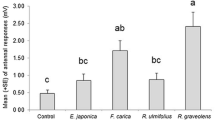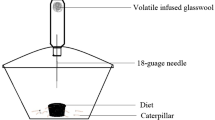Abstract
Flavonoids function in many aspects of plant–insect interactions, but the responses of insects to these compounds vary greatly. In this study, we determined the effects of two widely distributed flavonoids, pinocembrin and quercetin, on the feeding behavior, survival, and development of the fall armyworm Spodoptera frugiperda J.E. (Smith) (Lepidoptera: Noctuidae). In a choice test, S. frugiperda larvae strongly rejected leaves treated with pinocembrin at concentrations of 10, 50, or 100 μg/cm2. Larvae fed normally on leaves treated with quercetin at 10 and 50 μg/cm2, but showed 57 % deterrence when fed on leaves treated with 100 μg/cm2 quercetin. At concentrations of 0.01–1 µg/cm2, pinocembrin and quercetin functioned as phagostimulants for S. frugiperda. In a multiple-choice experiment, S. frugiperda larvae preferred to consume untreated leaves or those treated with 0.1 µg/cm2 pinocembrin, but rejected leaves treated with 5–50 µg/cm2 pinocembrin. In a no-choice feeding experiment, larvae fed on leaves treated with 5 and 50 μg/cm2 pinocembrin consumed less than those fed on leaves treated with 0.1 and 1 μg/cm2 pinocembrin or untreated leaves. Pinocembrin at 1–50 μg/cm2 negatively affected larval weight and survival, thus showing a toxic effect. In contrast, leaf consumption and larval weight were not significantly affected by quercetin at 0.1, 1, 5, and 50 μg/cm2, and mortality rates only slightly increased. Because of its dual activity, pinocembrin could be used for insect control in a stimulo-deterrent diversionary strategy: the same compound could promote both stimulate (low doses) and deter insect activity (high doses).




Similar content being viewed by others
References
Akhtar Y, Isman MB, Niehaus LA, Lee C-H, Lee H-S (2012) Antifeedant and toxic effects of naturally occurring and synthetic quinones to the cabbage looper, Trichoplusia ni. Crop Prot 31:8–14
Björkman M, Klingen I, Birch ANE, Bones AM, Bruce TJA, Johansen TJ, Meadow R, Mølmann J, Seljåsen R, Smart LE, Stewart D (2011) Phytochemicals of Brassicaceae in plant protection and human health—influences of climate, environment and agronomic practice. Phytochemistry 72:538–556
Bouaziz M, Simmonds MSJ, Grayer RJ, Kite GC, Damak M (2001) Flavonoids from Hyparrhenia hirta Stapf (Poaceae) growing in Tunisia. Biochem Syst Ecol 29:849–851
Carpinella C, Ferrayoli C, Valladares G, Defago M, Palacios S (2002) Potent limonoid insect antifeedant from Melia azedarach. Biosci Biotechnol Biochem 66:1731–1736
Carpinella MC, Defago MT, Valladares G, Palacios SM (2003) Antifeedant and insecticide properties of a limonoid from Melia azedarach (Meliaceae) with potential use for pest management. J Agric Food Chem 51:369–374
Céspedes CL, Calderón JS, Lina L, Aranda E (2000) Growth inhibitory effects on fall armyworm Spodoptera frugiperda of some limonoids isolated from Cedrela spp. (Meliaceae). J Agric Food Chem 48:1903–1908
Devappa RK, Angulo-Escalante MA, Makkar HPS, Becker K (2012) Potential of using phorbol esters as an insecticide against Spodoptera frugiperda. Ind Crops Prod 38:50–53
Di Blessing LT, Colom OÁ, Popich S, Neske A, Bardón A (2010) Antifeedant and toxic effects of acetogenins from Annona montana on Spodoptera frugiperda. J Pest Sci 83:307–310
Diaz Napal GN, Carpinella MC, Palacios SM (2009) Antifeedant activity of ethanolic extract from Flourensia oolepis and isolation of pinocembrin as its active principle compound. Bioresour Technol 100:3669–3673
Goławska S, Sprawka I, Łukasik I, Goławski A (2014) Are naringenin and quercetin useful chemicals in pest-management strategies? J Pest Sci 87:173–180
Harnly JM, Doherty RF, Beecher GR, Holden JM, Haytowitz DB, Bhagwat S, Gebhardt S (2006) Flavonoid content of U.S. fruits, vegetables, and nuts. J Agric Food Chem 54:9966–9977
Harwood M, Danielewska-Nikiel B, Borzelleca JF, Flamm GW, Williams GM, Lines TC (2007) A critical review of the data related to the safety of quercetin and lack of evidence of in vivo toxicity, including lack of genotoxic/carcinogenic properties. Food Chem Toxicol 45:2179–2205
Kumazawa S, Shimoi K, Hayashi K, Ishii T, Hamasaka T, Nakayama T (2004) Identification of metabolites in plasma and urine of Uruguayan propolis-treated rats. J Agric Food Chem 52:3083–3088
Mangeaud A, Videla M (2005) Looking for the lost of independence: using mixed generalized linear models in choice tests. Ecol Austral 15:199–206
Mazoir N, Benharref A, Bailén M, Reina M, González-Coloma A (2008) Bioactive triterpene derivatives from latex of two Euphorbia species. Phytochemistry 69:1328–1338
Miller JR, Cowles RS (1990) Stimulo-deterrent diversion: a concept and its possible application to onion maggot control. J Chem Ecol 16:3197–3212
Napal GND, Defagó M, Valladares G, Palacios S (2010) Response of Epilachna paenulata to two flavonoids, pinocembrin and quercetin, in a comparative study. J Chem Ecol 36:898–904
Palacios SM, Maggi ME, Bazán CM, Carpinella MC, Turco M, Muñoz A, Alonso RA, Nuñez C, Cantero JJ, Defago MT, Ferrayoli CG, Valladares GR (2007) Screening of Argentinian plants for pesticide activity. Fitoterapia 78:580–584
Pickett JA, Wadhams LJ, Woodcock CM (1997) Developing sustainable pest control from chemical ecology. Agric Ecosys Environ 64:149–156
Schramm K, Vassão DG, Reichelt M, Gershenzon J, Wittstock U (2012) Metabolism of glucosinolate-derived isothiocyanates to glutathione conjugates in generalist lepidopteran herbivores. Insect Biochem Mol 42:174–182
Simmonds MSJ (2003) Flavonoid-insect interactions: recent advances in our knowledge. Phytochemistry 64:21–30
Storer NP, Kubiszak ME, Ed King J, Thompson GD, Santos AC (2012) Status of resistance to Bt maize in Spodoptera frugiperda: lessons from Puerto Rico. J Invertbr Pathol 110:294–300
Tavares WDS, Cruz I, Petacci F, de Assis Júnior SL, de Sousa Freitas S, Zanuncio JC, Serrão JE (2009) Potential use of Asteraceae extracts to control Spodoptera frugiperda (Lepidoptera: Noctuidae) and selectivity to their parasitoids Trichogramma pretiosum (Hymenoptera: Trichogrammatidae) and Telenomus remus (Hymenoptera: Scelionidae). Ind Crops Prod 30:384–388
Tomquelski GV, Martins GLM (2007) Eficiência de insecticidas sobre Spodoptera frugiperda (J.E. SMITH, 1797) (Lepidoptera: Noctuidae) em milho na região dos Chapadões. Rev Bras Milho Sorgo 6:26–39
Tringali C, Spatafora C, Calì V, Simmonds MSJ (2001) Antifeedant constituents from Fagara macrophylla. Fitoterapia 72:538–543
Wyckhuys KAG, O’Neil RJ (2006) Population dynamics of Spodoptera frugiperda Smith (Lepidoptera: Noctuidae) and associated arthropod natural enemies in Honduran subsistence maize. Crop Prot 25:1180–1190
Acknowledgments
Financial support for this work was provided by the Agencia Nacional de Promoción Científica y Técnica, FONCYT, PICT 33593 and CONICET PIP 11220100100236. We thank Joss Heywood for revising the English language.
Author information
Authors and Affiliations
Corresponding author
Additional information
Communicated by M. B. Isman.
S.M. Palacios is a member of the National Research Council of Argentina (CONICET).
Rights and permissions
About this article
Cite this article
Diaz Napal, G.N., Palacios, S.M. Bioinsecticidal effect of the flavonoids pinocembrin and quercetin against Spodoptera frugiperda . J Pest Sci 88, 629–635 (2015). https://doi.org/10.1007/s10340-014-0641-z
Received:
Revised:
Accepted:
Published:
Issue Date:
DOI: https://doi.org/10.1007/s10340-014-0641-z




